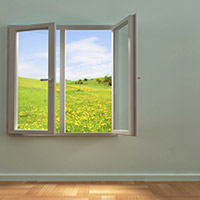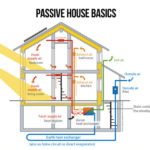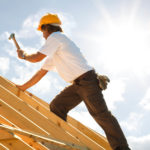
Summers are getting hotter. In fact, ten of the most sweltering years on record have been since 1998. Keeping a house cool is becoming a bigger challenge than ever. Sure, there’s always the option of cranking up the air conditioning but with the high-energy costs it’s worth reducing the load on the HVAC system as much as possible.
The roof and attic below are the hottest parts of the house and can transfer heat to the rest of the building. During the summer, the sun crosses the sky at a very high arc beating down directly on the roof. This heats up the shingles and attic below. If re-roofing, consider lighter shades of shingles that will reflect more heat than black ones.
Lack of ventilation in the attic can cause temperatures in excess of 150F. The attic can be cooled with either passive or active ventilation. With passive ventilation cooler air from the shade beneath the eaves is drawn in through the soffit vents or grilles. It is important to have enough openings to allow sufficient airflow to drive the heated air out of the roof vents or ridge cap vents.
If the amount of airflow is not sufficient active vents can also be added. These contain electric fans and can be controlled by a switch or thermostat. They can be quite costly and in some cases may suck too much drawing air conditioned air from the house into the attic.
Even with proper attic ventilation, it will still get hot. Another tip is to insulate this area from the rest of building as much as possible. In the past, most attics were only insulated to R-11 or R-15. These days, this can be easily increased to R-30 or R-50. This will also be of great benefit in the winter as well. The ceiling beneath the attic should also be well sealed to prevent hot air being forced through any gaps.
Doors, Windows and Ceiling Fans
Consider closing off rooms that are not needed and add weather stripping to windows and exterior doors to prevent hot air getting in and cool air getting out.
According to Family Handyman, up to 30% of heat comes from your windows. They will let in a lot of heat. Keeping blinds and shades closed will block most of that heat especially on the sunny side of the house. Windows can be upgraded to triple pane with low-E glass. Low-E will reflect the infrared waves of the sun back outside. It is also possible to add Low-E tinted film or foil to windows.
Windows on the sunny side of the house will also benefit from having awnings to keep them in the shade. In fact, by planting trees and tall shrubs the entire sunny side of the house can become shaded.
Good ventilation is essential. Apart from opening windows on the shady side of the house ceiling fans can be run in a counter-clockwise direction to create a cooling breeze. Use bathroom fans to remove hot humid air from bathrooms and a powerful range hood to extract hot air coming from stoves. These fans can also be left on to help remove some of the hot air rising to the top of the room. Try cooking and doing laundry during the cooler times of the day as well. Humidity makes a house seem hotter and more uncomfortable so a dehumidifier would be a worthwhile addition in humid areas.
A whole house fan is another option. The fan is positioned in the ceiling between the main living space and an attic. It pulls warm air into the attic creating a positive pressure differential forcing the hot air outside through the roof and soffit vents. In turn, it creates negative pressure in the living space, which will pull cooler outside air in through open windows.
There are many heat sources in the house including incandescent light bulbs that can be replaced with cool LED ones. Large screen TVs can emit a lot of heat so keep them off until night time. Besides, you should be outside enjoying the hot weather!



